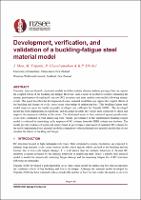| dc.contributor.author | Mou, Junan | |
| dc.contributor.author | Tripathi, Mayank | |
| dc.contributor.author | Dhakal, Rajesh | |
| dc.contributor.author | Chandramohan, Reagan | |
| dc.date.accessioned | 2023-08-28T04:23:25Z | |
| dc.date.available | 2023-08-28T04:23:25Z | |
| dc.date.issued | 2023-04-19 | |
| dc.identifier.uri | https://repo.nzsee.org.nz/xmlui/handle/nzsee/2573 | |
| dc.description.abstract | Currently, there are limited constitutive models available in finite element analysis packages that reliably capture the coupled effects of bar buckling and fatigue. However, such a model is needed for reliable estimation of the seismic performance of RC structures and their residual capacity/life following seismic events. Hence, this paper describes the development of a steel material model that captures the coupled effects of bar buckling and fatigue. This buckling-fatigue steel model improves upon the model originally developed and calibrated by Tripathi (2020). The implementation of the developed model in OpenSees is then discussed, along with the verification tests conducted to test the numerical stability of the model. The developed model is then validated against pseudo-static cyclic tests conducted on bare reinforcing bars. Finally, the performance of implemented buckling-fatigue model is evaluated by simulating the behaviour of reinforcing bars within RC columns from the PEER column database, and the improvement in performance assessment of simulated RC columns using the newly implemented material model and the traditional steel material models that do not simulate the effects of buckling and fatigue is quantified. | |
| dc.language.iso | en | |
| dc.publisher | New Zealand Society for Earthquake Engineering | |
| dc.relation.ispartofseries | 2023;50 | |
| dc.subject | Other topics related to earthquake engineering and its application | |
| dc.title | Development, verification, and validation of a buckling-fatigue steel material model | |
| dc.type | Article | |

